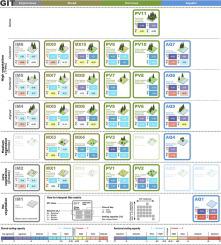当前位置:
X-MOL 学术
›
Landsc. Urban Plan.
›
论文详情
Our official English website, www.x-mol.net, welcomes your
feedback! (Note: you will need to create a separate account there.)
Quantifying the seasonal cooling capacity of ‘green infrastructure types’ (GITs): An approach to assess and mitigate surface urban heat island in Sydney, Australia
Landscape and Urban Planning ( IF 7.9 ) Pub Date : 2020-11-01 , DOI: 10.1016/j.landurbplan.2020.103893 Carlos Bartesaghi-Koc , Paul Osmond , Alan Peters
Landscape and Urban Planning ( IF 7.9 ) Pub Date : 2020-11-01 , DOI: 10.1016/j.landurbplan.2020.103893 Carlos Bartesaghi-Koc , Paul Osmond , Alan Peters

|
Abstract Green infrastructure (GI) can help moderate urban overheating and mitigate surface urban heat islands (SUHIs) by providing protection from solar radiation, cooling surfaces through evapotranspiration, and modifying heat exchanges through advection. However, more research is needed to determine the optimum amounts, compositions and configurations of GI necessary to provide maximum thermal cooling and mitigate urban warming more effectively. In this study, a recently developed ‘green infrastructure typology’ (GIT) scheme is applied in Sydney, Australia to analyse the interplay and cumulative cooling effects of natural and artificial elements in summer and winter by considering their morphological and spatial characteristics. Thermal-vegetation index (TVX), simple linear regression and correlation analyses were performed to identify factors that are more influential on the cooling effects of GI. After, a hierarchical cluster analysis was performed to group types with similar cooling capacity, representing potential mitigation strategies that could be implemented at local scale. Results presented here demonstrate that the cooling effect of different types of GI on surface temperatures mostly depend on the abundance and composition of natural and man-made features. As thermal performance of GI depends on the interplay between both, this study offers a more holistic and integrated approach to assess and counter urban overheating. Key insights derived from the analysis are presented to provide a better understanding on which aspects of GI and urban form should be considered to mitigate SUHIs more effectively in neighbourhoods urban precincts and streets.
中文翻译:

量化“绿色基础设施类型”(GIT)的季节性冷却能力:评估和缓解澳大利亚悉尼地表城市热岛的方法
摘要 绿色基础设施 (GI) 可以通过提供免受太阳辐射的保护、通过蒸发蒸发冷却表面以及通过平流改变热交换来帮助缓解城市过热和缓解地表城市热岛 (SUHI)。然而,需要更多的研究来确定提供最大热冷却和更有效缓解城市变暖所必需的 GI 的最佳量、组成和配置。在这项研究中,澳大利亚悉尼应用了最近开发的“绿色基础设施类型学”(GIT)方案,通过考虑自然和人工元素的形态和空间特征来分析它们在夏季和冬季的相互作用和累积冷却效应。热植被指数(TVX),进行了简单的线性回归和相关分析,以确定对 GI 冷却效果影响更大的因素。之后,执行分层聚类分析以将具有相似冷却能力的类型分组,代表可以在本地范围内实施的潜在缓解策略。这里展示的结果表明,不同类型的 GI 对地表温度的冷却效果主要取决于自然和人造特征的丰度和组成。由于 GI 的热性能取决于两者之间的相互作用,因此本研究提供了一种更全面和综合的方法来评估和应对城市过热。
更新日期:2020-11-01
中文翻译:

量化“绿色基础设施类型”(GIT)的季节性冷却能力:评估和缓解澳大利亚悉尼地表城市热岛的方法
摘要 绿色基础设施 (GI) 可以通过提供免受太阳辐射的保护、通过蒸发蒸发冷却表面以及通过平流改变热交换来帮助缓解城市过热和缓解地表城市热岛 (SUHI)。然而,需要更多的研究来确定提供最大热冷却和更有效缓解城市变暖所必需的 GI 的最佳量、组成和配置。在这项研究中,澳大利亚悉尼应用了最近开发的“绿色基础设施类型学”(GIT)方案,通过考虑自然和人工元素的形态和空间特征来分析它们在夏季和冬季的相互作用和累积冷却效应。热植被指数(TVX),进行了简单的线性回归和相关分析,以确定对 GI 冷却效果影响更大的因素。之后,执行分层聚类分析以将具有相似冷却能力的类型分组,代表可以在本地范围内实施的潜在缓解策略。这里展示的结果表明,不同类型的 GI 对地表温度的冷却效果主要取决于自然和人造特征的丰度和组成。由于 GI 的热性能取决于两者之间的相互作用,因此本研究提供了一种更全面和综合的方法来评估和应对城市过热。











































 京公网安备 11010802027423号
京公网安备 11010802027423号